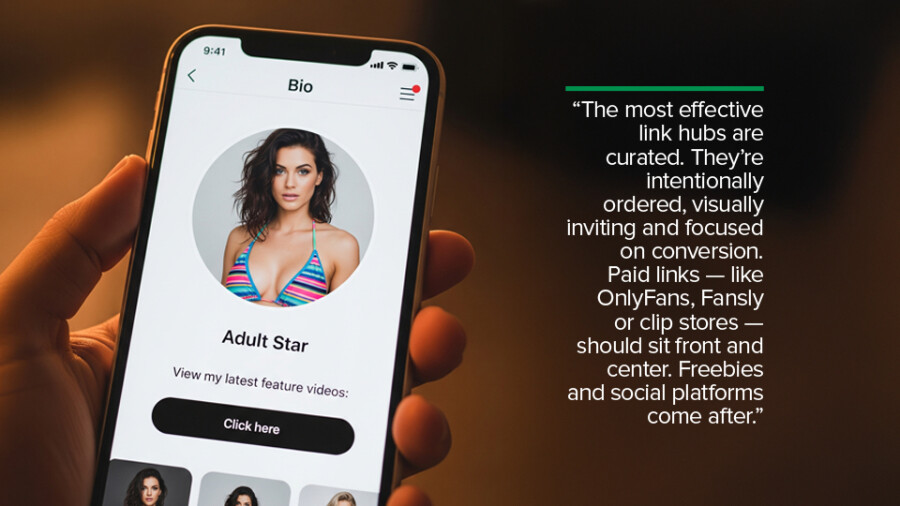In
the
world
of
adult
content,
where
platforms
play
favorites
and
policy
changes
happen
overnight,
“link
in
bio”
isn’t
just
a
digital
afterthought
—
it’s
a
frontline
tool.
A
well-crafted
link
hub
can
turn
a
casual
viewer
into
a
paying
customer.
Yet
far
too
many
creators
treat
their
link
page
like
a
neglected
parking
lot:
messy
and
littered
with
broken
promises.
Let’s
change
that.
The
most
effective
link
hubs
are
curated.
They’re
intentionally
ordered,
visually
inviting
and
focused
on
conversion.
Below
are
some
tips
for
optimizing
your
link
hub.
As
you
will
see,
it
takes
more
than
just
throwing
your
platforms
into
a
list.
It’s
about
choosing
the
right
tool,
shaping
the
experience
and
making
every
click
count
—
all
while
staying
compliant
with
the
ever-shifting
rules
of
social
media
and
billing
platforms.
Mainstream
Tools
Aren’t
Built
for
Us
For
many
creators,
tools
like
Linktree
or
Beacons
are
the
default
go-to.
They’re
simple,
widely
known
and
easy
to
set
up.
But
here’s
the
problem:
These
platforms
weren’t
built
for
the
adult
industry.
They’re
powered
by
mainstream
ad
networks
and
payment
processors,
which
means
content
that
even
hints
at
sexuality
can
trigger
a
“shadow
ban”
or
get
your
entire
page
pulled.
Some
creators
wake
up
one
morning
to
find
that
their
link
no
longer
works
or
their
traffic
has
mysteriously
disappeared.
That’s
why
adult
creators
need
NSFW-friendly
alternatives
that
respect
the
business
we’re
in.
Tools
like
AllMyLinks
and
GetAllMyLinks
were
built
with
us
in
mind.
They
offer
verified
profiles,
affiliate
support,
analytics
and
—
most
importantly
—
terms
of
service
that
don’t
punish
you
for
being
a
sex
worker.
They
may
not
get
the
mainstream
buzz,
but
in
many
ways,
that’s
their
strength.
They
fly
under
the
radar,
but
they
do
the
job
right.
Curate
With
Care
Once
you’ve
chosen
your
tool,
the
next
question
is:
Are
you
using
it
effectively?
Most
creators
don’t
regularly
update
their
link
in
bio
or
test
their
links.
Instead
of
actively
guiding
their
fans
toward
conversion,
they
just
list
everything
and
hope
something
gets
clicked.
That’s
not
a
strategy;
that’s
roulette.
The
most
effective
link
hubs
are
curated.
They’re
intentionally
ordered,
visually
inviting
and
focused
on
conversion.
Paid
links
—
like
OnlyFans,
Fansly
or
clip
stores
—
should
sit
front
and
center.
Freebies
and
social
platforms
come
after.
Why?
Because
attention
spans
are
short,
so
the
first
few
links
are
the
ones
that
matter
most.
Don’t
bury
your
gold
under
your
Instagram
handle.
Language
also
plays
a
huge
role.
Generic
buttons
like
“Subscribe
Here”
or
“Cam
Site”
might
be
functional,
but
they
don’t
sell.
A
fan
is
more
likely
to
click
on
“Watch
Me
Live”
or
“Unlock
My
Private
Feed”
because
those
phrases
tap
into
desire.
Every
word
in
your
link
hub
should
act
like
a
mini
ad:
punchy,
clear
and
personal.
Some
platforms
let
you
embed
previews
in
the
form
of
images,
GIFs
or
even
short
clips.
Use
that
feature
if
you
can.
Visuals
convert
better
than
text
alone
—
especially
on
mobile,
where
most
users
scroll
fast
and
click
impulsively.
Passive
Income
Lives
Here
Too
Your
link
hub
can
do
more
than
just
point
fans
toward
platforms.
It
can
also
bring
in
passive
income.
Affiliate
links
are
an
easy
way
to
generate
extra
revenue.
If
you
promote
a
favorite
toy,
link
to
it
with
your
partner
code.
If
you’re
on
clip
sites
that
offer
referral
payouts,
add
those
too.
Even
tip
jars
or
digital
gift
links
can
make
a
difference,
especially
when
paired
with
a
subtle
incentive.
A
tip-for-a-pic
promo,
for
example,
can
drive
both
engagement
and
cash.
That
said,
not
all
tracking
is
visible
to
fans.
Smart
creators
use
link
shorteners
like
Bitly
or
Switchy.io
to
monitor
what’s
actually
performing.
You
might
think
your
tip
jar
is
getting
all
the
clicks,
but
the
data
could
tell
a
different
story.
Without
analytics,
you’re
guessing.
With
it,
you’re
optimizing.
Don’t
Get
Shadow-Banned
Over
Sloppy
Linking
There
are
some
risks
to
avoid.
The
fastest
way
to
get
shadow-banned
is
to
link
directly
to
explicit
content
from
your
Instagram
or
TikTok
profile.
Social
platforms
are
hypersensitive
to
adult
content;
even
if
your
link
hub
is
technically
allowed,
the
content
you
connect
to
can
still
trigger
filters.
That’s
why
it’s
always
better
to
use
a
neutral
landing
page
as
a
buffer,
with
no
nudity
or
explicit
text
in
the
preview.
It’s
also
smart
to
test
your
link
from
a
burner
account
or
a
browser
you’re
not
logged
into.
What
you
see
as
a
creator
isn’t
always
what
the
public
sees.
Broken
links,
loading
errors
or
blocked
previews
can
cost
you
clicks
and
income
without
you
realizing
it.
Your
Link
in
Bio
Is
Prime
Real
Estate
Ultimately,
your
link
in
bio
should
reflect
the
same
care
you
put
into
your
content.
It
should
be
clean,
compelling
and
conversion-focused.
This
is
prime
real
estate,
not
just
a
utility.
If
it
hasn’t
been
updated
in
three
months,
it’s
probably
costing
you
money.
If
your
most
recent
promo
isn’t
reflected
there,
you’re
losing
momentum.
If
your
traffic
is
flatlining,
it
might
not
be
the
algorithm
—
it
might
be
your
links.
Take
20
minutes
this
week
and
audit
your
setup.
Check
every
link.
Rewrite
your
calls
to
action.
Swap
out
anything
that
isn’t
performing.
If
your
current
tool
is
starting
to
feel
like
a
liability,
don’t
wait
for
it
to
crash.Get
an
upgrade.
Your
link
in
bio
is
more
than
just
a
line
of
text.
It’s
a
bridge
between
interest
and
income.
Build
it
with
purpose,
polish
it
with
care
and
let
it
work
for
you,
even
when
you’re
offline.
Megan
Stokes
is
co-founder
of
NMG
Management,
specializing
in
content
distribution
and
management.
As
a
veteran
of
the
adult
industry,
she
enjoys
sharing
the
knowledge
and
data
she
has
collected
over
time
with
those
who
seek
her
help.

